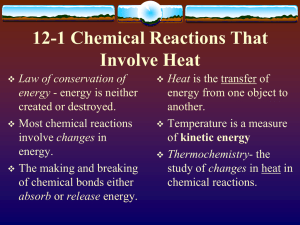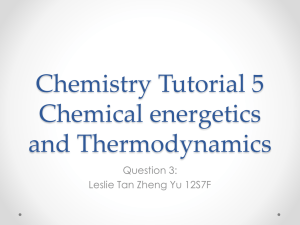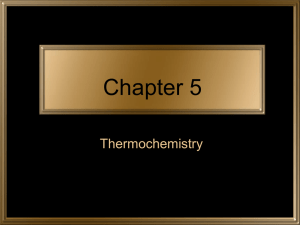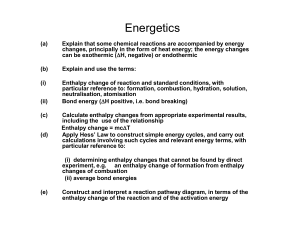Thermodynamics Notes
advertisement
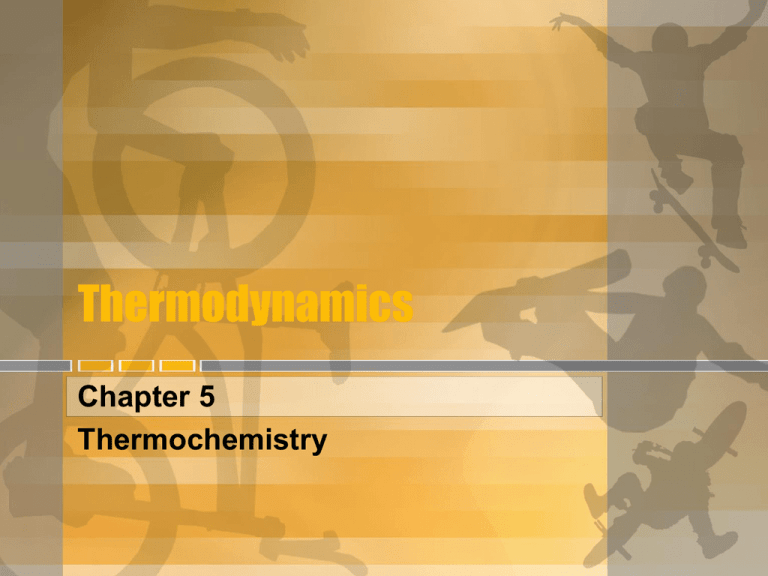
Thermodynamics Chapter 5 Thermochemistry Thermochemistry •Thermodynamics – study of energy and its transformation. •Thermochemistry – relationship of energy changes in chemical reactions. The Nature of Energy Force Work Heat Energy is the “push” or “pull” exerted on an object. is the energy required to overcome a force. w = force * distance the transfer of energy from one object to another because of a difference in temperature capacity to due work or to transfer heat. Energy •Kinetic – energy due to an objects motion (Ke = ½ mv^2) represents the performance of work •Potential – energy due to an objects position relative to another object – represents the capacity to due work •Usage of Energy Energy Units • Joule (S.I. Unit) energy of a 2 kg obj traveling at a velocity of 1 m/s 1 J = 1kg –m^2/s^2 • Calorie (cal) – energy req to raise the temp of 1 g of water 1 deg C. • 1 cal = 4.184 J • In foods 1 Cal = 1000 cal = 1kcal Thermo Environment’s System A. Open B.Closed part of the universe considered (reactants, products, etc) both energy and matter can be transferred into or out of energy can be trans into or out but not matter C.Isolated neither energy or matter can be trans into or out of the system Surrounds all other parts of the universe including the vessel The First Law of Thermodynamics • "Energy can neither be created nor destroyed". Another approach is to say that the total energy of an isolated system remains constant. • Law of conservation of energy = 1st law of thermo • Internal Energy (U or E) consist of all the energy of a system – sum of potential and kinetic energies First Law Cont. • Internal Energy can not be measured however changes in energy can be • Delta U or E is defined as the change in internal energy • DU = E final – E initial • + DU energy is gained by system or (endothermic) • - DU energy is lost by the system of (exothermic) First Law cont. • Delta U = q + w is another way of expressing the first law q = heat = integral c delta t c = heat capacity delta t = change in tempt q = + heat absorbed q = - heat released w = work = neg integral p delta v p = external pressure delta v = change in volume w = + done to system w = - done by system State Functions • Depend on the current state of the system and are independent on the pathway leading to the current state • Internal Energy U is an example of a state function • q and w are not state functions • Delta H enthalpy = q ( pressure constant) Thermochemical Equations • Balanced chemical equations that show the associated enthalpy change • ex. 2Na(s) + 2H2O(l) 2NaOH(aq) + H2(g) (delta H = -367.5kj) * note – the enthalpy change depends on the phase of the substances Thermochem eq • Ex 2H2(g) + O2(g) 2H2O(g) DH -483.7kj • 2H2(g) + O2(g) 2H2O(l) DH -571.7kj • Molar Interpretation 2 moles of H2 and 1 mole of O2 react give liquid water and 572kj of heat evolve How much heat would evolve if one mole of H2 reacted 1H2(g) +1/2 O2(g) 1H2O(l) DH -286kj 1H2O(l) 1H2(g) +1/2 O2(g) DH 286kj Heat and Enthalpy Change • The amount of energy in an open system is best described by the amount of heat produced ( little work is done because the atmosphere produces little resistance) • Enthalpy- is the amount of heat contained by substance (can’t measure - can only measure change in a system at cons. pressure) • DH = q (p) (constant pressure) Delta H enthalpy •Is a state function •DH = H final – H initial products – reactants DH = (-) exothermic DH = (+) endothermic Calculating the heat of reactions • How much heat is evolved when 907 kg of ammonia is produced according to the following equation (-2.45 x 10^6kj) N2(g) + 3H2(g) 2NH(g) DH = -91.8kj Thermo Problems Cont. • Ammonia burns in the presence of copper catalyst to form nitrogen gas. What is the enthalpy change to burn 25.6g of ammonia? 4NH3(g) + 3O2(g) 2N2 + 6H2O(g) DH= -1267kj Calorimetry (measurement of heat flow) •Heat Capacity of an obj (C) is the amt of heat necessary to raise tits tempt by 1 deg C •Is directly port to the amt of the sub. • q = Cdt C = q/dt •So molar heat capacity is often used- the amt of heat necessary to raise the temp of one mole 1 deg C Specific Heat • heat capacity of 1g of a substance is called its specific heat capacity of specific heat • s = q (quantity of heat trans)/ m(grams of sub x dt (temp change) • Calc the amt of heat a substance has gained or lost q = s x grams sub x dt Hess’s Law for a chem eq that can be written as the sum of two or more steps, the enthalpy change for the overall eq equals the sum of the enthalpy changes for the individual parts

